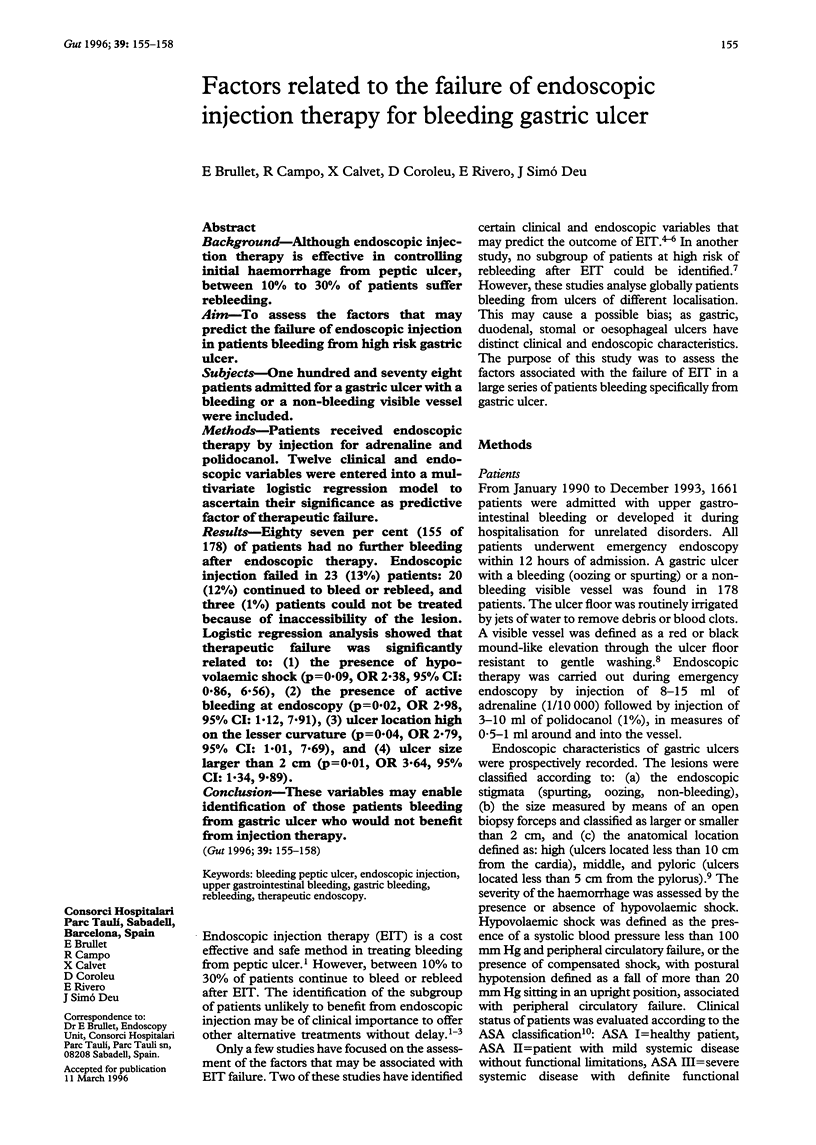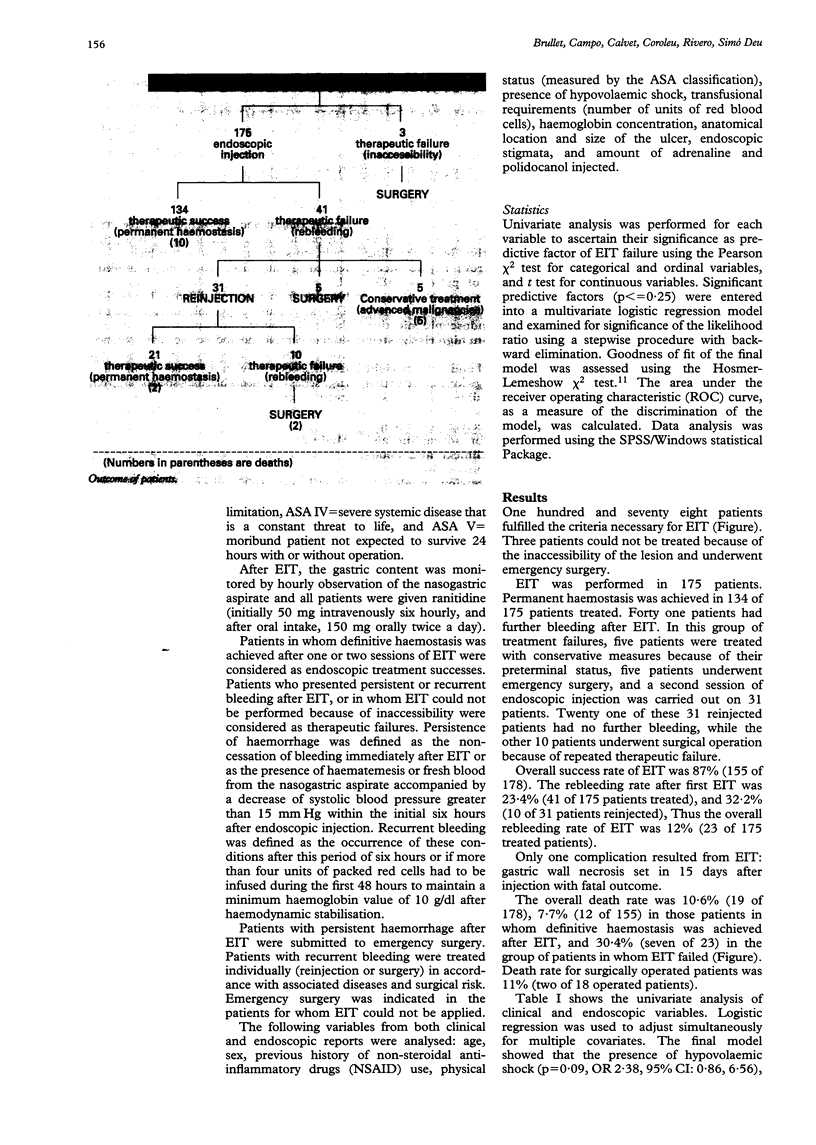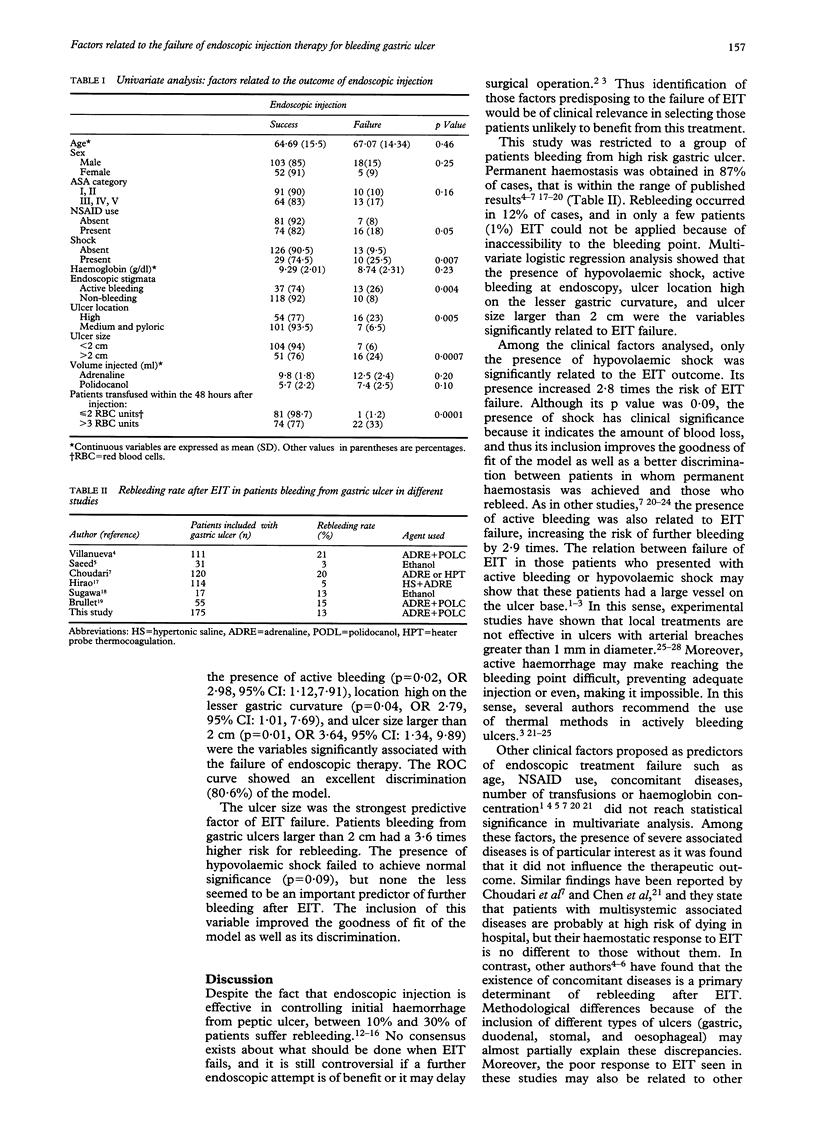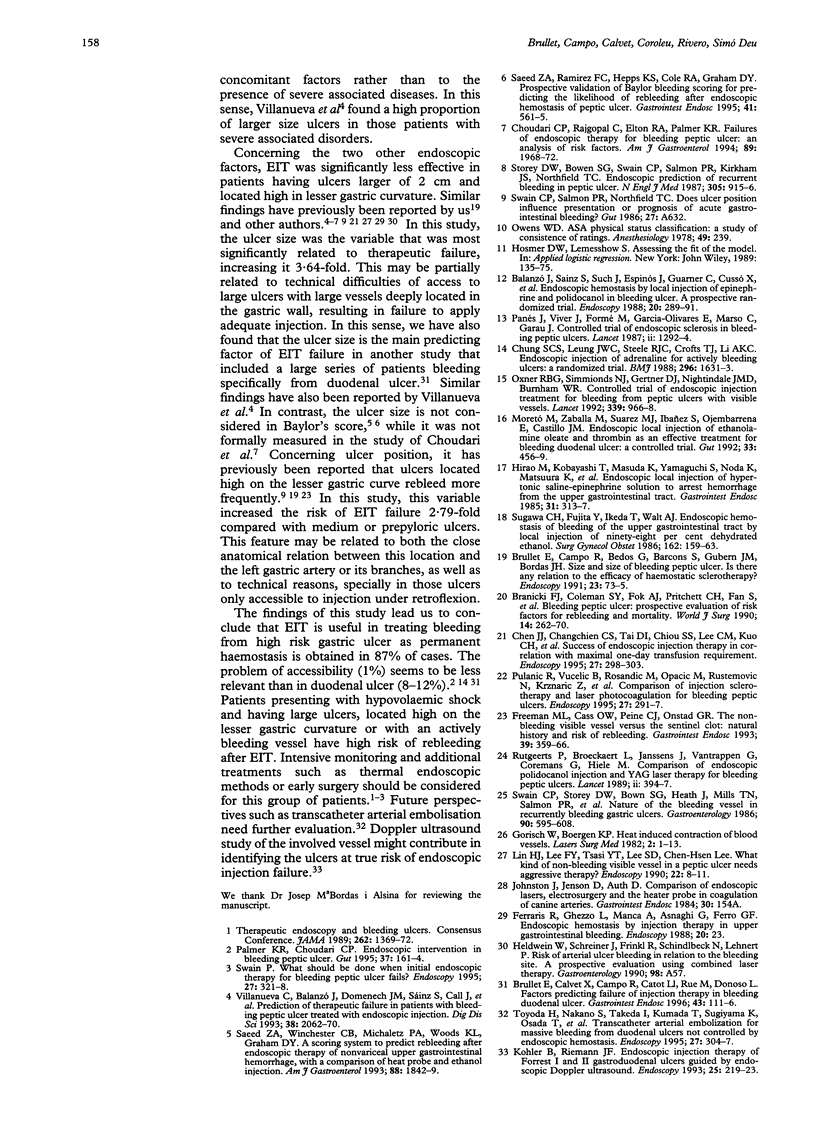Abstract
BACKGROUND: Although endoscopic injection therapy is effective in controlling initial haemorrhage from peptic ulcer, between 10% to 30% of patients suffer rebleeding. AIM: To assess the factors that may predict the failure of endoscopic injection in patients bleeding from high risk gastric ulcer. SUBJECTS: One hundred and seventy eight patients admitted for a gastric ulcer with a bleeding or a non-bleeding visible vessel were included. METHODS: Patients received endoscopic therapy by injection for adrenaline and polidocanol. Twelve clinical and endoscopic variables were entered into a multivariate logistic regression model to ascertain their significance as predictive factor of therapeutic failure. RESULTS: Eighty seven per cent (155 of 178) of patients had no further bleeding after endoscopic therapy. Endoscopic injection failed in 23 (13%) patients: 20 (12%) continued to bleed or rebleed, and three (1%) patients could not be treated because of inaccessibility of the lesion. Logistic regression analysis showed that therapeutic failure was significantly related to: (1) the presence of hypovolaemic shock (p = 0.09, OR 2.38, 95% CI: 0.86, 6.56), (2) the presence of active bleeding at endoscopy (p = 0.02, OR 2.98, 95% CI: 1.12, 7.91), (3) ulcer location high on the lesser curvature (p = 0.04, OR 2.79, 95% CI: 1.01, 7.69), and (4) ulcer size larger than 2 cm (p = 0.01, OR 3.64, 95% CI: 1.34, 9.89). CONCLUSION: These variables may enable identification of those patients bleeding from gastric ulcer who would not benefit from injection therapy.
Full text
PDF



Selected References
These references are in PubMed. This may not be the complete list of references from this article.
- Balanzó J., Sainz S., Such J., Espinós J. C., Guarner C., Cussó X., Monés J., Vilardell F. Endoscopic hemostasis by local injection of epinephrine and polidocanol in bleeding ulcer. A prospective randomized trial. Endoscopy. 1988 Nov;20(6):289–291. doi: 10.1055/s-2007-1013023. [DOI] [PubMed] [Google Scholar]
- Branicki F. J., Coleman S. Y., Fok P. J., Pritchett C. J., Fan S. T., Lai E. C., Mok F. P., Cheung W. L., Lau P. W., Tuen H. H. Bleeding peptic ulcer: a prospective evaluation of risk factors for rebleeding and mortality. World J Surg. 1990 Mar-Apr;14(2):262–270. doi: 10.1007/BF01664889. [DOI] [PubMed] [Google Scholar]
- Brullet E., Calvet X., Campo R., Rue M., Catot L., Donoso L. Factors predicting failure of endoscopic injection therapy in bleeding duodenal ulcer. Gastrointest Endosc. 1996 Feb;43(2 Pt 1):111–116. doi: 10.1016/s0016-5107(06)80110-0. [DOI] [PubMed] [Google Scholar]
- Brullet E., Campo R., Bedos G., Barcons S., Gubern J. M., Bordas J. M. Site and size of bleeding peptic ulcer. Is there any relation to the efficacy of hemostatic sclerotherapy? Endoscopy. 1991 Mar;23(2):73–75. doi: 10.1055/s-2007-1010616. [DOI] [PubMed] [Google Scholar]
- Chen J. J., Changchien C. S., Tai D. I., Chiou S. S., Lee C. M., Kuo C. H., Chiu K. W., Chuah S. K., Lin C. C. Success of endoscopic injection therapy in correlation with maximal one-day transfusion requirement. Endoscopy. 1995 May;27(4):298–303. doi: 10.1055/s-2007-1005696. [DOI] [PubMed] [Google Scholar]
- Choudari C. P., Rajgopal C., Elton R. A., Palmer K. R. Failures of endoscopic therapy for bleeding peptic ulcer: an analysis of risk factors. Am J Gastroenterol. 1994 Nov;89(11):1968–1972. [PubMed] [Google Scholar]
- Chung S. C., Leung J. W., Steele R. J., Crofts T. J., Li A. K. Endoscopic injection of adrenaline for actively bleeding ulcers: a randomised trial. Br Med J (Clin Res Ed) 1988 Jun 11;296(6637):1631–1633. doi: 10.1136/bmj.296.6637.1631. [DOI] [PMC free article] [PubMed] [Google Scholar]
- Freeman M. L., Cass O. W., Peine C. J., Onstad G. R. The non-bleeding visible vessel versus the sentinel clot: natural history and risk of rebleeding. Gastrointest Endosc. 1993 May-Jun;39(3):359–366. doi: 10.1016/s0016-5107(93)70106-6. [DOI] [PubMed] [Google Scholar]
- Gorisch W., Boergen K. P. Heat-induced contraction of blood vessels. Lasers Surg Med. 1982;2(1):1–13. doi: 10.1002/lsm.1900020101. [DOI] [PubMed] [Google Scholar]
- Hirao M., Kobayashi T., Masuda K., Yamaguchi S., Noda K., Matsuura K., Naka H., Kawauchi H., Namiki M. Endoscopic local injection of hypertonic saline-epinephrine solution to arrest hemorrhage from the upper gastrointestinal tract. Gastrointest Endosc. 1985 Oct;31(5):313–317. doi: 10.1016/s0016-5107(85)72213-4. [DOI] [PubMed] [Google Scholar]
- Kohler B., Riemann J. F. Endoscopic injection therapy of Forrest II and III gastroduodenal ulcers guided by endoscopic Doppler ultrasound. Endoscopy. 1993 Mar;25(3):219–223. doi: 10.1055/s-2007-1010296. [DOI] [PubMed] [Google Scholar]
- Lin H. J., Lee F. Y., Tsai Y. T., Lee S. D., Lee C. H. What kind of non-bleeding visible vessel in a peptic ulcer needs aggressive therapy? Long-term clinical observation. Endoscopy. 1990 Jan;22(1):8–11. doi: 10.1055/s-2007-1012778. [DOI] [PubMed] [Google Scholar]
- Moretó M., Zaballa M., Suárez M. J., Ibáez S., Ojembarrena E., Castillo J. M. Endoscopic local injection of ethanolamine oleate and thrombin as an effective treatment for bleeding duodenal ulcer: a controlled trial. Gut. 1992 Apr;33(4):456–459. doi: 10.1136/gut.33.4.456. [DOI] [PMC free article] [PubMed] [Google Scholar]
- Mumps meningitis following measles, mumps, and rubella immunisation. Lancet. 1989 Aug 12;2(8659):394–395. [PubMed] [Google Scholar]
- Owens W. D., Felts J. A., Spitznagel E. L., Jr ASA physical status classifications: a study of consistency of ratings. Anesthesiology. 1978 Oct;49(4):239–243. doi: 10.1097/00000542-197810000-00003. [DOI] [PubMed] [Google Scholar]
- Oxner R. B., Simmonds N. J., Gertner D. J., Nightingale J. M., Burnham W. R. Controlled trial of endoscopic injection treatment for bleeding from peptic ulcers with visible vessels. Lancet. 1992 Apr 18;339(8799):966–968. doi: 10.1016/0140-6736(92)91537-i. [DOI] [PubMed] [Google Scholar]
- Palmer K. R., Choudari C. P. Endoscopic intervention in bleeding peptic ulcer. Gut. 1995 Aug;37(2):161–164. doi: 10.1136/gut.37.2.161. [DOI] [PMC free article] [PubMed] [Google Scholar]
- Panés J., Viver J., Forné M., Garcia-Olivares E., Marco C., Garau J. Controlled trial of endoscopic sclerosis in bleeding peptic ulcers. Lancet. 1987 Dec 5;2(8571):1292–1294. doi: 10.1016/s0140-6736(87)91191-3. [DOI] [PubMed] [Google Scholar]
- Pulanić R., Vucelić B., Rosandić M., Opacić M., Rustemović N., Krznarić Z., Brkić T., Jokić-Begić N. Comparison of injection sclerotherapy and laser photocoagulation for bleeding peptic ulcers. Endoscopy. 1995 May;27(4):291–297. doi: 10.1055/s-2007-1005695. [DOI] [PubMed] [Google Scholar]
- Saeed Z. A., Ramirez F. C., Hepps K. S., Cole R. A., Graham D. Y. Prospective validation of the Baylor bleeding score for predicting the likelihood of rebleeding after endoscopic hemostasis of peptic ulcers. Gastrointest Endosc. 1995 Jun;41(6):561–565. doi: 10.1016/s0016-5107(95)70191-5. [DOI] [PubMed] [Google Scholar]
- Saeed Z. A., Winchester C. B., Michaletz P. A., Woods K. L., Graham D. Y. A scoring system to predict rebleeding after endoscopic therapy of nonvariceal upper gastrointestinal hemorrhage, with a comparison of heat probe and ethanol injection. Am J Gastroenterol. 1993 Nov;88(11):1842–1849. [PubMed] [Google Scholar]
- Storey D. W., Bown S. G., Swain C. P., Salmon P. R., Kirkham J. S., Northfield T. C. Endoscopic prediction of recurrent bleeding in peptic ulcers. N Engl J Med. 1981 Oct 15;305(16):915–916. doi: 10.1056/NEJM198110153051603. [DOI] [PubMed] [Google Scholar]
- Sugawa C., Fujita Y., Ikeda T., Walt A. J. Endoscopic hemostasis of bleeding of the upper gastrointestinal tract by local injection of ninety-eight per cent dehydrated ethanol. Surg Gynecol Obstet. 1986 Feb;162(2):159–163. [PubMed] [Google Scholar]
- Swain C. P., Storey D. W., Bown S. G., Heath J., Mills T. N., Salmon P. R., Northfield T. C., Kirkham J. S., O'Sullivan J. P. Nature of the bleeding vessel in recurrently bleeding gastric ulcers. Gastroenterology. 1986 Mar;90(3):595–608. doi: 10.1016/0016-5085(86)91113-3. [DOI] [PubMed] [Google Scholar]
- Swain P. What should be done when initial endoscopic therapy for bleeding peptic ulcer fails? Endoscopy. 1995 May;27(4):321–328. doi: 10.1055/s-2007-1005701. [DOI] [PubMed] [Google Scholar]
- Toyoda H., Nakano S., Takeda I., Kumada T., Sugiyama K., Osada T., Kiriyama S., Suga T. Transcatheter arterial embolization for massive bleeding from duodenal ulcers not controlled by endoscopic hemostasis. Endoscopy. 1995 May;27(4):304–307. doi: 10.1055/s-2007-1005697. [DOI] [PubMed] [Google Scholar]
- Villanueva C., Balanzó J., Espinós J. C., Domenech J. M., Sáinz S., Call J., Vilardell F. Prediction of therapeutic failure in patients with bleeding peptic ulcer treated with endoscopic injection. Dig Dis Sci. 1993 Nov;38(11):2062–2070. doi: 10.1007/BF01297086. [DOI] [PubMed] [Google Scholar]


